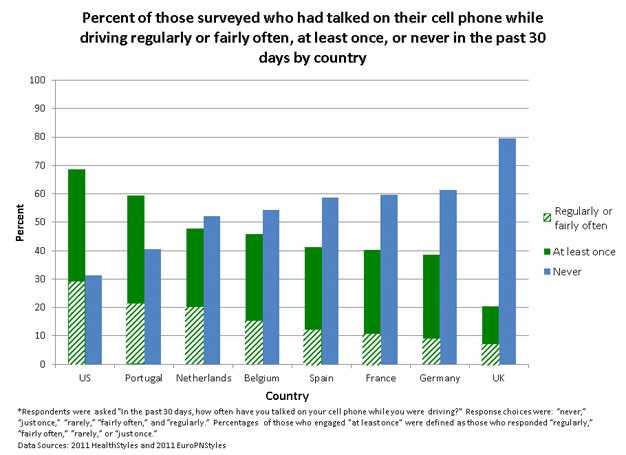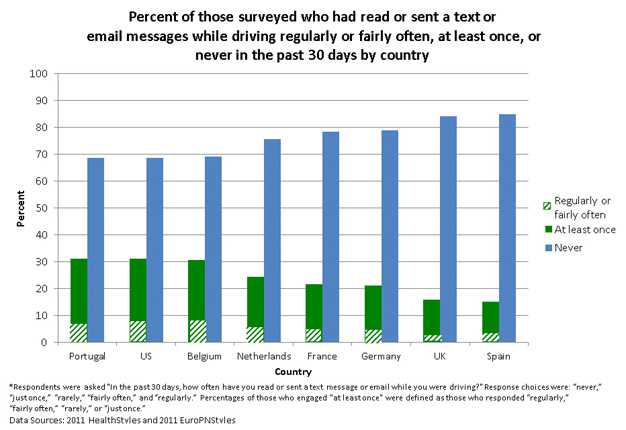Distracted Driving in the United States and Europe
 Take steps to be safe on the road. Start by practicing good driving habits. Don’t text and drive.
Take steps to be safe on the road. Start by practicing good driving habits. Don’t text and drive.
Have you ever read or sent a text message while driving and then had to slam on the brakes to avoid hitting another car? Or have you missed an exit or turn because you were distracted by a phone call? It only takes seconds for a crash to happen. Distracted driving makes crashes all the more likely.
Distracted Driving: More of a Problem in the United States than in Europe
Talking, texting, and reading email behind the wheel may be more of a problem in the United States than in Europe. A 2011 CDC study compared the percentage of distracted drivers in the United States and seven European countries: Belgium, France, Germany, the Netherlands, Portugal, Spain, and the United Kingdom. Overall, the study found that a higher percentage of U.S. drivers talked on the phone and read or sent emails or texts while driving than drivers in several other European countries. For example, the study found that 69 percent of U.S. drivers ages 18-64 years old reported that they had talked on their cell phone while driving within the 30 days before they were surveyed, compared to drivers from the United Kingdom.
The study also found that about one-third of drivers in the United States reported that they had read or sent text messages or emails while driving, compared to just 15 percent of drivers from Spain.
Distracted Driving in the United States: a Problem on the Rise
Each day, more than nine people are killed and 1,060 more are injured in crashes that involve a distracted driver. Consider that:
- In 2012, 3,328 people were killed in crashes involving a distracted driver compared to 3,360 in 2011.
- In 2012, 421,000 people were injured in motor vehicle crashes involving a distracted driver.
- In 2011, "distraction" was reported as being a factor in nearly one in five crashes (17 percent) in which someone was injured.
- In December 2012, more than 171 billion text messages were sent or received in the United States.
Distracted driving increases your chance of being in a crash. It involves doing another activity that takes your attention away from driving
There are three main types of distraction:
- Visual─taking your eyes off the road,
- Manual─taking your hands off the wheel, and
- Cognitive─taking your mind off of driving.
Distracted driving activities include using a cell phone, texting, and eating. Using in-vehicle technologies (such as navigation systems) can also be sources of distraction. While any of these can endanger the driver and others, texting while driving is especially dangerous because it combines all three types of distractions.


Take Steps to Be Safe
There are several things you can do to keep yourself and others safe on the road:
Steps for all drivers:
- Model safe behavior behind the wheel—never text and drive.
- Always stay focused and alert when driving.
- Take the pledge—commit to distraction-free driving.
- Speak out if the driver in your car is distracted.
- Encourage your friends and family to designate their cars a “no phone” zone when driving.
- Spread the word—get involved in promoting safe driving in your community.
Steps for parents of teen drivers:
- Know and obey the laws in your state. Many states have Graduated Driver Licensing (GDL) laws that include cell phone and texting bans for young drivers.
- Discuss what it means to be a safe driver with your teen and set ground rules for when they are behind the wheel.
- Make a family pledge and have other members in your family commit to distraction-free driving.
- Set a positive example for your teen by putting your cell phone away every time you drive.
CDC is committed to saving lives and protecting people from injury and violence. For more information about distracted driving, please visit www.cdc.gov/Motorvehiclesafety/Distracted_Driving.
More Information
CDC Resources
- Eyes on the Road – A Minute of Health with CDC [PODCAST 0:59 seconds]
- Eyes on the Road – A Cup of Health with CDC [PODCAST 04:43 minutes]
- Distracted Driving
- Motor Vehicle Safety
- State-based Costs of Deaths from Crashes(https://www.cdc.gov/Motorvehiclesafety/statecosts/index.html)
- Costs and Prevention Policies
- MMWR: Mobile Device Use While Driving — United States and Seven European Countries, 2011
External Resources
- Page last reviewed: October 20, 2014
- Page last updated: October 20, 2014
- Content source:
- National Center for Injury Prevention and Control
- Page maintained by: Office of the Associate Director for Communication, Digital Media Branch, Division of Public Affairs




 ShareCompartir
ShareCompartir